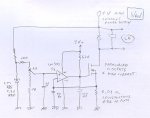IRFP054 is a good choice for high currents, it can easily keep 60A (64 max) continuous in ON state with a maximum voltage of 60V and can dissipate til 230W max ..... but for use it as current source in a current stabilizer, if you plan to build a variable or "modulable" system, i suggest you to use at least 2 of them, with a good heatsink (not that just one can't hold it, but i'm a maniac of safety ..... paralleling 2 of them, you divide the power dissipation that each one have to dissipate, and double the safety level of the circuit) ..... the only possible problem is that they require too much current for the gate, so you need to use a second op-amp as buffer, but this is the least problem.
Anyway, also with just one of them, coupled with a good heatsink, just for precaution, you must be safe, if you need a decent output current regulator ..... it have a decently low RDSon, so also the dissipation is relatively low ..... just optimize the input voltage of the circuit for keep the dissipated energy as low as possible, (say, 3V, max 3,5V) without compromise the function of the regulation, and you're OK (but with this current value you probably have to lower the resistance that is connected from the potentiometer and ground ..... all these values depend from the final current that you want ..... as example, i suggest you to change that part of the circuit in this way: in place of the 1 K resistor, a 4.7 Kohm trimmer, and in place of the 1 K potentiometer, a 3.3Kohm one, and considering that this circuit was designed for lower mosfets, change the 47K resistor between the positive and the gate with a 10Kohm one .....
Depending from your setup, may also be necessary to use a 0.05 ohm or less resistor as sense resistor, instead 0.1 ohm ..... with these low values, is usually better to use constantane wire resistors, or constantane plate ones, and can be put more than one in parallel, if you don't find the needed values ..... it's practically impossible to measure them with normal multimeters, you need a milliohmeter, or just buy them already made for the needed values ..... also, considerate that also this resistor hold the same current that you have at the output, so you need to dimension it for the right power ..... just as example, if you use a 0.01 ohm one, with 50 A you have 0.5V on it, that means 25W of dissipation ..... so, at least 40 or 50W resistor is needed for not "cook" it .....
Then, you can set a maximum current that is under the limit of the mosfet, during the setup ..... turning both the trimmer and the potentiometer for the minimum current, with an amperometer in serie to the load, powering up the unit, turning the potentiometer for the maximum current (keeping an eye on the amperometer

), then turning the trimmer until you reach the maximum value that you want, paying attention to never go over 55A or similar ..... in this way, the current remain regulable in a certain range, but never go over the limit set with the trimmer.
Ofcourse, i suggest you to do these tests using a dummy load that can hold these currents and dissipate these powers ..... the better choice can be a LEDed diode bar similar to the good one, still working as diode and eating power, but already damaged as laser, so it's the more similar to the real one ..... in alternative, a low value BIG resistor, like, 0.1 ohm 200W wire resistor, can be ok
BTW, if you find a precision 0.01 ohm resistor, you can easily use it also for measure the current, just placing a millivoltmeter in parallel with the resistor ..... at 200mv scale, the usual scale of these meters, each mV is 1A, and cause they are 3 1/2 cyphers, you have an instrument that measure til 199A with 100mA steps
And, just as suggestion, if you don't find the right type of shunt resistor in any electronic shops (is not easy, i know it for personal experience), there's an alternative on ebay, that is a bit uncommon, but that can work good ..... there's for sale a lot of relatively cheap lcd or led meters, that are proposed already set for certain ranges, like, 200VAC, 20VDC, 200ADC , and so on ..... the 200A DC ones, are sold
with a shunt resistor that is already the right value and power that you probably need .....






